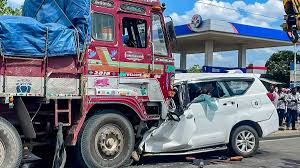Death on the move: On India’s disgraceful record in fatal road accidents.
Road accidents are not resulting in overhaul of infrastructure and licensing.
The highway accident on November 3, 2025 that claimed 19 lives at Chevella near Hyderabad was far too routine to change India’s disgraceful record in fatal road accidents. The driver of a gravel-laden truck apparently swerved to avoid a pothole and rammed into a bus. There were no dividers, no streetlights and no signages on that stretch of National Highway 163. India’s roads are a major public hazard. Pedestrians, bus riders and two-wheeler motorists constitute the majority of the over 400 people who die on India’s roads on average, the equivalent to a full transcontinental flight going down. Flight disasters invite scrutiny, multi-agency probes and quick remedial actions but road accident deaths that mostly involve poorer folk trigger perfunctory probes and glacial change in rules, if any. Government documents identify human error as the most common cause but deeper reasons — vehicular and infrastructural — are unaddressed.
In India, the road test for getting a driving licence examines whether the person is able to handle a vehicle of certain specification, largely a skill test, rather than one of his knowledge and execution of safe driving practices. No safety training is mandated. Most accidents are collisions from the back — whereas exemplar driving tests in other countries filter out tailgating tendencies and arbitrary lane changing. The system of certifying and monitoring drivers and vehicles is broken and corrupt. For nearly all Indians, navigating RTOs is unpleasant. The SaveLIFE Foundation advocates License Seva Kendras — on the lines of Passport Seva Kendras — so that they are transparent, digitised, and ensure good driver skills and safety awareness. One in five accidents are head-on collisions, which have happened even on four-lane highways, indicating wrong-side driving and the state of road dividers. In general, national highways need to adhere to Indian Roads Congress guidelines but States have made no mandates as required by the Motor Vehicles Act. There are potholes, dangerous curves, drainage systems, bridge parapets and concrete objects, but no crash barriers or energy absorbers. Collision-risk warning devices are relatively inexpensive and can be mandated on commercial vehicles. Better pedestrian infrastructure alone can prevent many fatalities. In Hyderabad, a community health-care centre was available for immediate treatment and a government hospital was not far away. But that is often not the case elsewhere. In States such as Bihar, fatality rates are double because of inadequate trauma care infrastructure. An overhaul of the road transport system is an urgent requirement in India.
